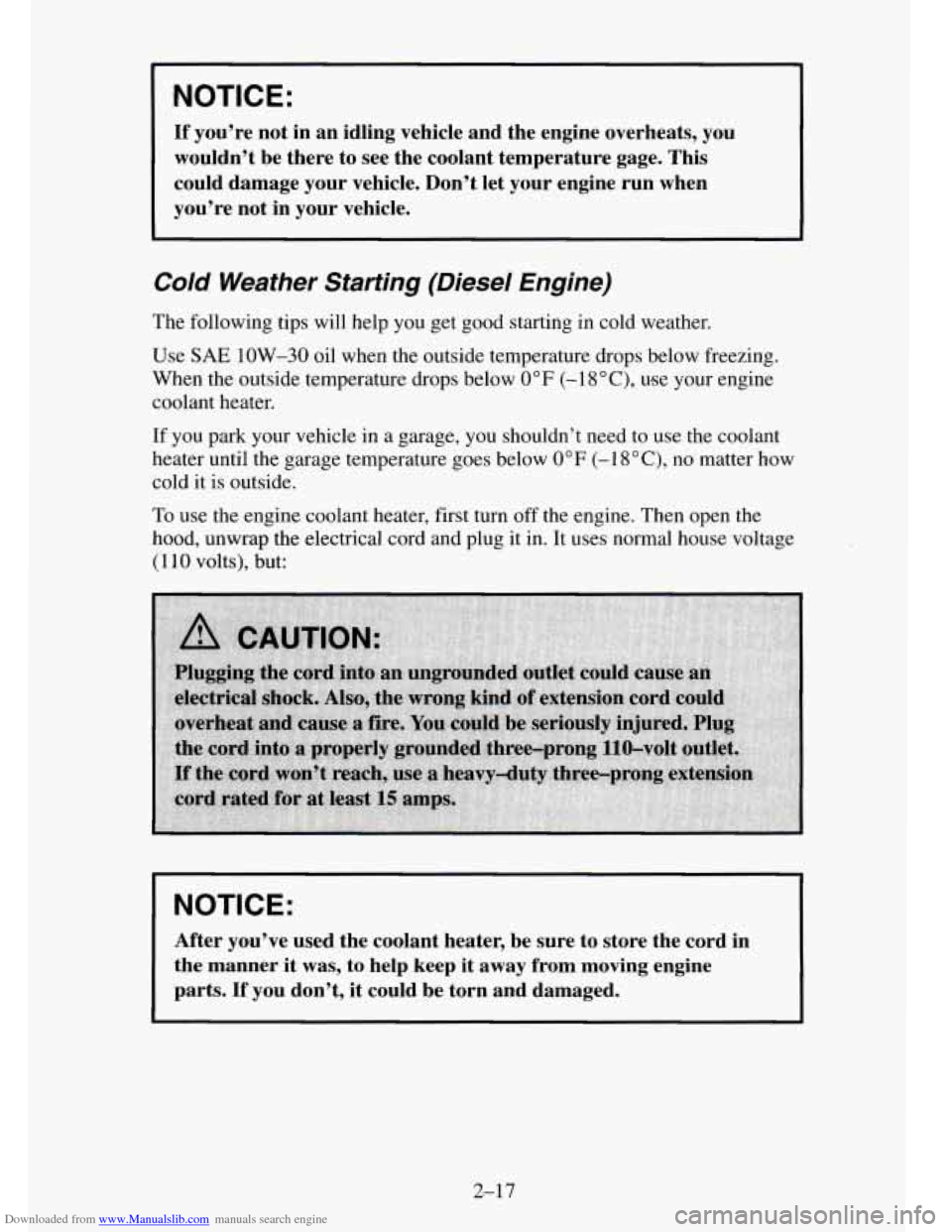Page 84 of 486

Downloaded from www.Manualslib.com manuals search engine NOTICE:
If you’re not in an idling vehicle and the engine overheats, you
wouldn’t be there to see the coolant temperature gage. This
could damage your vehicle. Don’t let your engine run when
you’re not in your vehicle.
Cold Weather Starting (Diesel Engine)
The following tips will help you get good starting in cold weather.
Use
SAE 1OW-30 oil when the outside temperature drops below freezing.
When the outside temperature drops below
0” F (- 18 O C), use your engine
coolant heater.
If you park your vehicle
in a garage, you shouldn’t need to use the coolant
heater until the garage temperature goes below
0°F (-1 8OC), no matter how
cold it is outside.
To use the engine coolant heater, first turn off the engine. Then open the
hood, unwrap the electrical cord and plug
it in. It uses normal house voltage
(110 volts), but:
I NOTICE:
After you’ve used the coolant heater, be sure to store the cord in
the manner it was, to help keep it away from moving engine
parts.
If you don’t, it could be torn and damaged.
2-17
Page 86 of 486
Downloaded from www.Manualslib.com manuals search engine Engine Coolant Heater (Option)
4
m
In very cold weather, 0°F (-1 8 "C) or colder, the engine coolant heater can
help. You'll get easier starting and better fuel economy during engine
warm-up. Usually, the coolant heater should be plugged in
a minimum of
four hours prior
to starting your vehicle.
To use the coolant heater:
1. Turn off the engine.
2. Open the hood and unwrap the electrical cord.
3. Plug it into a normal, grounded 1 IO-volt outlet.
Page 237 of 486
Downloaded from www.Manualslib.com manuals search engine Turn off the ignition on both vehicles. Turn off all lights that aren’t
needed, and radios. This will avoid sparks and help save both batteries.
And it could
save your radio!
I NOTICE:
If you leave your radio on, it could be badly damaged. The
repairs wouldn’t be covered by your warranty.
Open the hoods and locate the batteries. Find the positive (+) and
negative
(-) terminals on each battery.
Check that the jumper cables don’t have loose or missing insulation. If
they do, you could get a shock. The vehicles could be damaged, too.
Before
you connect the cables, here are some basic things you should
know. Positive
(+) will go to positive (+) and negative (-) will go to
negative (-) or a metal engine part. Don’t connect (+) to (-) or you’ll
get a short that would damage the battery and maybe other parts, too.
5-4
Page 290 of 486
Downloaded from www.Manualslib.com manuals search engine Checking Things Under the Hood
Hood Release
To open the hood, first
pull the handle inside
the vehicle.
Then go to the front
of
the vehicle and pull up
on the secondary hood
release, located just
to
the passenger side of
the center
of the grill.
Lift the hood.
Your vehicle, if it has
air conditioning, may
have
a auxiliary
engine fan in addition
to the belt driven fan.
6-13